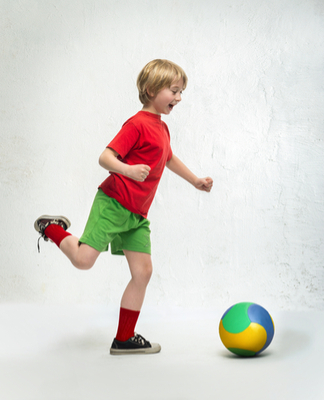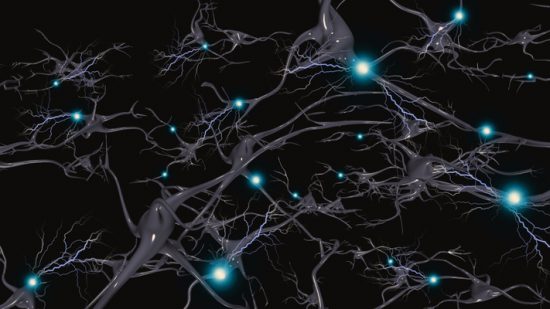Visual Processing Disorder (VPD) covers a variety of vision issues that have nothing to do with being near or farsighted. Does your child think that a square and a triangle look the same? Does she bump into things, because she doesn’t understand where objects are in relation to her body? Does she have trouble understanding that numbers and letters come in a certain order? All of these issues can be signs of a visual processing disorder. In VPD, the brain has trouble processing signals that come from the eyes.
A child with VPD may pass her vision test with flying colors because her eyes are fine. The problem is the way her brain deals with visual information. VPD is not something a person outgrows, but there are ways to cope with the challenges of having a visual processing disorder.
We think of our vision as something to do with the eyes, but it is much more than that. It is the brain that is responsible for using the information from our eyes to create images and impressions. But sometimes the brain doesn’t understand visual information as it should.
The eyes may send you the message that in front of you on a piece of paper is the shape of a triangle. But the brain may only see the image as a shape and not be able to tell you which kind of shape it is. The eyes may see a house a short way down the road, but the brain says that the house is far away. When the brain doesn’t see visual information as it should, it means that brain function is weak in these areas. And that is called visual processing disorder.

Visual processing disorders aren’t considered learning disabilities, but as you might suspect, they are common in children with learning issues. Just as dyslexia or dyscalculia have to do with a difference or weakness in brain function, so do visual processing disorders. When the brain is weak in one area, it is often weak in more than one area. This is why someone with VPD will often have other learning disorders. When someone has two disorders or disabilities at the same time, the conditions are said to be comorbid.
VPD can affect the way a child learns. But a visual processing disorder can also affect everyday tasks like putting away the forks and knives into their correct slots in the silverware drawer, or sinking a ball into a basketball hoop. Visual processing disorders can even affect the way a child feels about himself. To his classmates, a child with VPD may be the kid who can never get that ball into the hoop. And so the child may withdraw into himself, to avoid the frustration and pain that come with being different.
Visual processing disorder is complicated. There are eight different types of visual processing disorders but many people have more than one kind of VPD. Since visual processing issues don’t show up in a simple vision test, it could be your child will go through school without anyone picking up on the fact that he has a visual processing problem.

Eight Types of Visual Processing Disorders
Here are the eight types of visual processing disorders (remember that a child may have any combination of these forms of VPD):
- Visual discrimination: The child may not see the difference between similar shapes. He may mix up b and d and may not see the difference between a circle or an oval, for instance.
- Visual figure-ground discrimination: The child can’t pick out a person or a shape when seen against the background on a page. He may not be able to find specific information on a web page.
- Visual sequencing: The child doesn’t know that B and C always follow A, or that 4 follows 3. When he reads, he may skip lines because he doesn’t understand the idea of “next” as in “the next line.” Sometimes children with visual sequencing problems reverse letters or words.
- Visual-motor processing: The child has trouble using the feedback he gets from his eyes to coordinate the way other parts of his body move, for instance, the hands or the feet. He may knock into things or find it difficult to turn the pages in a book.
- Long/short-term visual memory: Show the child a picture, take it away, and ask him what he saw. The child with visual memory problems won’t remember. This type of VPD also makes it hard to remember the letters and numbers he has been taught in class and the books he has read. Visual memory issues can get in the way of using calculators and keyboards.
- Visual-spatial: The child has trouble understanding where things are within space. This affects his understanding of how close or far items are to them or to each other. The same may be true of objects he sees in a picture. Visual spatial issues can make it hard for a child to judge how much time has gone by, and it can make it difficult for him to read a map, too.
- Visual closure: A child may not understand that a smiley face is a face, because it is missing ears and hair. A truck without wheels may not be recognized as a truck. If the teacher gives a worksheet where students have to fill in missing letters or words, a child with visual closure issues may not be able to do the work.
- Letter and symbol reversal: Most kids reverse letters when they first begin to write. But if he’s still mixing up b and d and p after the age of 7, it may be due to a visual processing disorder. This sort of disorder can make reading, writing, and math work difficult.

VPD: How Common is it?
No one really knows how common visual processing issues are, especially since a lot of the time, these disorders go undetected. But we do know that the signs of VPD often show up in kids with learning disorders, for instance in children with dyslexia. Dyslexia is the most common learning disorder in America, where it is thought that as many as one in every five children has dyslexia. That translates to lots of kids who also have VPD.
What Causes VPD?
Again, no one really knows the cause of visual processing disorder. But if you think of the brain as a sort of circuit board where the wires can get tangled or kinked and even disconnected, you’ll have a pretty good picture of how VPD works. The eyes send a signal to the brain, but the signal crosses with a different one, or there’s a kink in the wiring that keeps the signal from going through to the right part of the brain. Or perhaps, the wire is narrower in parts. The brain’s synapses, responsible for mapping out information and sending messages, are very much like wires. The eye sees what it sees, but the brain fails to understand the information sent to it by the eyes.

Is it VPD?
Here are some signs that a child may have a visual processing disorder:
- Turns away from large amounts of visual information, such as the sight of a busy picture
- Fidgets during videos or PowerPoint presentations
- Does a sloppy job with visual tasks, for instance, sweeping the floor
- Doesn’t like to see movies or watch television
- Can’t deal with copying from the blackboard
- Mixes up shapes, letters, numbers, and words
- Always bumping into things, is clumsy
- Can’t stay inside the lines when writing or drawing
- Finds it hard to spell words he knows that have unusual spelling patterns, for instance he can never quite remember that “quite” is not “quiet”
- Can’t remember even his own phone number
- Doesn’t understand what he reads when he reads silently, to himself
- Cannot remember common facts read silently, for instance, that H2O is water
- When reading, he reads the same sentence over and over again, or skips too far down the page for the “next” line
- Says his eyes hurt, rubs them often
- His reading comprehension and writing skills are poor, but his verbal and oral comprehension skills are average or even strong
- His math skills are weak because he leaves out steps, overlooks function signs, or mixes up similar types of math problems
- Often fails to note changes to displays and signs, or new notices posted to bulletin boards

What’s A Parent to Do?
If you suspect your child has one or more visual processing disorders, there are many things you can do to help. Keep in mind that helping your child learn to cope will take patience and lots of work. Here are some of the things you can do at home that may be helpful:
- Read up on visual processing disorder. Knowledge is your best tool for helping your child with VPD.
- Watch your child as she does different tasks and take notes on what you see. Does she do tasks differently than most children? Writing down what you observe will help everyone in your child’s life understand her particular challenges and tell them how to respond.
- Always be clear when writing out schedules or instructions. Break up instructions into numbered steps. Write things out in large letters and use colors, too. When assigning household chores, you might use a different color for each sibling. If “sweep the steps” is written in purple, for instance, that means it’s Tommy’s task
- Use your child’s free time for activities improve visual processing, but turn things into a game. Do a puzzle together. Read. Play catch.
- Offer lots of praise for real achievements. If your child worked hard on studying for his spelling test and improved his grade, let him know you’re pleased. He needs your support and recognition to keep on going, because it’s such a struggle! Let him know you know that.
Found what you just read useful? Why not consider sending a donation to our Kars4Kids youth and educational programs. Or help us just by sharing!
Editor’s note: This post was originally published Nov 14, 2017, and has been completely revised and updated for accuracy and scope.

Wondering what accommodations you recommend for my 8th grader who is having trouble comprehending blocks of information at times. I tend to have this same issue however if I read allowed it helps a great deal. I do not suspect reading allowed in class would be acceptable. I was thinking maybe if she copied it to a scrap page, rewriting it would or could help with comprehension. What are your thoughts?
That sounds like a great plan! Let her read aloud at home, and copy and rewrite in class, if the teacher agrees.
•His math skills are weak because he leaves out steps, overlooks function signs, or mixes up similar types of math problems. This statement describes my son to a T.
What can I do for him to pass Algebra he is a freshman in high school, and really getting discouraged. I find articles that describe the issue however no specific remedies to help with math.
I think it would be helpful for your son to be tested. This way, the problem would be clarified and could then be properly addressed by an expert. I would suggest you find a tutor with experience in teaching children with VPD. The tutor would break down problems with your son and help him logically work the problems, step by step. It may also help for him to have larger type for his assignments. Experiment with using different colors for different parts of equations. Let him know you get it: it’s hard. Praise him when he tries and especially when he succeeds
I was diagnosed as dyslexic in high school in the 1990s when it is probably VPD that is the core issue. Maybe VPD is a newer diagnosis? I haven’t been able to find that information and found this website while looking for that.
For math, what worked for me to get around the not seeing/discriminating/remembering function signs, often not seeing decimal points or the thin little dashed line telling me something is a negative (especially a problem when it’s at the start of the sequence so I can’t easily notice that a number is spaced differently, though I have trouble seeing the vertical line in + sometimes as well and mistake it for the division symbol or a -) so when I was working on my Master’s Degree and taking Graduate Statistics, my coursework was all provided as a Word Doc and my exams were proctored in the University’s Disability Services Office. I highlighted and selected out the numbers, pasted them into the Windows calculator, did the necessary calculations in there while using the copy-paste abilities to keep from having number sequences or decimals scramble around in the sequences, and showed my work by pasting every step of the calculation into the Word doc of my exam. It’s a lot slower than writing/keying by hand that people who don’t have visual/motor processing issues have, so I was also given 1.5x time to take the tests (another reason that they were proctored in the DSO instead of taken in class). With those relatively simple accommodations, I was able to earn an A in a class that many of my classmates had to repeat due to low marks (might have been an A- but like I said I have trouble seeing those dash marks!). Outside that class, I accommodate my issues as a sociologist doing survey research by keeping everything digital so I can manipulate the numbers via copy-paste or batch processes without having my transcribing issues muddy things, which is really simple to do by strongly encouraging my survey respondants to take the online version, or doing one-on-one survey-taking with the ones who will not enter their responses digitally themselves and just entering the survey responses into the software for them myself, then using SPSS (which I can also easily batch-process the numbers if I find that I coded a response backwards, i.e. if 5 was supposed to mean “strongly agree” but I accidentally put 5 as “strongly disagree” it’s a very easy fix for the entire dataset and pretty quickly obvious when that error has occurred).
I thought some reassurance that such workarounds are readily available might help your child keep their chin up and get through this. My 8th grader with similar issues is currently enrolled in Algebra and FINALLY getting access to the workarounds I have been recommending all year as of this week and a 90min phone conference with the Special Ed coordinator and his Algebra teacher. In my opinion, the earlier that kids figure out the workarounds that get them to the result that they need using their inherent intellectual capabilities, the better it is for their success in life. We’re humans, we’re SUPPOSED to be adaptable to our environments AND adapt our environments to our needs. It’s kinda one of the defining characteristics of our species, isn’t it? 😉
Hi 🙂 I know this comment is late however, I’m going into freshmen year and I struggle with the exact thing your describing your son does. For me it’s super frustrating. There will be times where I just brake down crying because it’s too much for me to handle and take in, like physically my brain can not handle that much. Taking things step by step is often the best way for me to fully comprehend the math subject or equation. Sadly it’s super time consuming but if I don’t take it step by step everything gets jumbled up. I do suggest ( if you have not already) trying to get your son in for a test even though school boards can be quite frustrating and not diagnose you correctly. In my school system we have something called the 5o4 plan. This is a plan for students who might need accomidationis for certain reasons. For example, I have this plan because I originally got tested for dyslexia but got diagnosed with visual spacial reasoning skills. Other kids have it for reasons such as anxiety or depression. They can now make accomidationis for me such as having extra time on test and stuff (taking stuff step by step) and giving me chances to make note cards for certain tests. If your school system does not have anything like that I would certainly try to explain to them how helpful it would be for students. I personally know how mentally draining it is to have a learning condition to struggle with. Even writing this now is kinda frustrating because i’m awful at writing and getting words into the right format. I have suffered from terrible anxiety and depression as well and sometimes my visual spatial skills add onto that and it makes me feel like i’m actually stupid and dumb. I feel so frustrated with myself. I am also an art student at a high school in New Haven and not only do I struggle with math, but it also ties into art as well. All my visual spatial skills are messed up and to me I look around and see all these other incredible artists that have great proportions on their work and I get super discouraged. Another difficult thing about spatial skills is that it’s incorporated in a lot of things like everyday tasks and I think for a lot of people they don’t understand how hard it can be to deal with the learning disability. I also feel a lot of people don’t understand how it fully effects a persons learning and what academics it’s tough in. Everyone with visual spatial disabilities are different. It seems like your son and I both struggle similarly in math class but we could both struggle in different ways in English or science class. If you have any questions you would like to ask me then please do but until then I hope your son is doing well and that you guys can work this out if you have not already.
ps. i’m very sorry if my writing is hard to understand
My son have ADHD and has failed school every year since 3rd grade and only pass ,by going to Summer School with Paraprofessional. I really think my son has VPD ,because he can’t remember nothing. I feel the teachers just thinks he LAZY. He feeling down , less motivated ,lack of confidence . I have a appointment to get him tested
Hello- Why is it that VPD descriptions of symptoms seem to include a likelihood that the child will not be good at sports (eg have trouble throwing/catching a ball or playing basketball), but my son is an excellent athlete (basketball and baseball) and yet has all the other symptoms of VPD that I’ve read about, and was also just tested by the school which is where the issues came to light (previously we attributed his learning issues primarily to ADHD, which he clearly also has).
Thanks!
Was he diagnosed with VPD after his recent testing?
I’ve been having trouble with my vision for about 18 months. I was diagnosed with intracranial hypertension and did sustain some permanent damage to my sight. The pressure in my head is okay now, but I’m still having problems with my new glasses. Today at the optometrist’s office they gave me a screening questionnaire for VPD. I have an appointment in a few weeks to see the optometrist again. But I was wondering, is getting lost (while driving or walking) a sign of VPD? I can get lost so easily, it’s actually affected my career path. What about forgetting where you parked? And I can be completely oblivious to poster/sign changes. I also have poor math skills. Does this sound like these issues could be caused be VPD?
Doctors have a saying: “When you hear hoof beats, think horses, not zebras.”
You’ve already been diagnosed with a condition that affects your vision. There is no reason to suspect there is a different or additional reason for these issues. That said, you should mention it to your optometrist and it also wouldn’t hurt for you to see an opthalmologist.
Correction:
Visual processing deficits are considered a contributing factor in a learning disability. It’s one of the psychological processes that create gaps in a child’s learning.
Thank you for this information. My daughter is doing well with reading, she reads a lot, but she really battles with math, remembering things, tying knots, sports where a lot of limbs are required, like skiing and dance routines, and now learning how to drive, which is so scary. Do you have any recommendations for that? Or is it something we just have to constantly work on? Thank you again Mrs. Epstien this sight is very helpful.
I’m glad your daughter is doing well with reading and has the comfort of books, what with so many issues to deal with. I would definitely have her assessed. But what it sounds like to me, is stealth dyslexia (See: https://parenting.kars4kids.org/stealth-dyslexia-does-your-child-have-an-issue/), or more specifically, dyspraxia (See: https://parenting.kars4kids.org/developmental-coordination-disorder-dcd-why-is-my-child-so-clumsy/). Speak to your family doctor or pediatrician about how to have your daughter evaluated. The most common treatment for DCD (dyspraxia) is occupational therapy. Sometimes physiotherapy is also helpful.